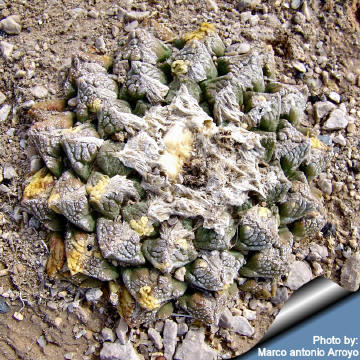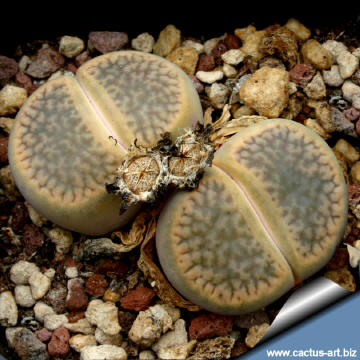|

A. fissuratus
Photo and © Copyright by Marco Antonio Arroyo - Mexico )
The
mimetic colouring of a plant in its natural
habitat in Cuatro Cienegas, Coahuila -
Commonly called "living rocks," these cacti usually blend in well with
the terrain around them.

Lithops hookeri subfenestrata C19
A "living rock" that comes from the equally
shiny dark and implausibly shiny ironstone substrate.
|
- Living rock cacti: The term “living rock cactus”
refers to several Mexican genera of dwarf, cryptophyte cacti
plants, and particularly to cacti belonging to the genus
Ariocarpus (especially
A. fissuratus).
The “living rock” are low-growing plants that live almost
buried in the ground and often have a rosette of tubercles
that are flattened and resemble (for colour and texture) the
surrounding soil surface. Most of this plants almost entirely
lack spines but are covered by warty tubercles and woolly
hairs, so they often mimicry the stones among they grow (hence
the name living stones). Water is stored against the dry
season in the thickened tap-root or in the underground plant
body reservoirs. Often these plants melt so efficaciously with
the background that are completely invisible if not flowered.
Other cacti that are usually called living rock comprises:
Astrophytum,
Aztekium,
Epithelantha,
Geohintonia,
Lophophora,
Obregonia,
Turbinicarpus and
Strombocactus
- Living rock mesebrianthemums: The term living rock
(or living stone) is also used to indicate several South
African members of the Aizoaceae family (especially
Lithops) that are highly succulent stemless
clump-forming plants with variously coloured leaves similar in
texture to lumps of rock. The colour of the plant is that of
the natural rock where they live. Other succulent that are
usually called living rock comprises:
Pleiospilos,
Conophytum,
Titanopsis,
Lapidaria, ecc..
|